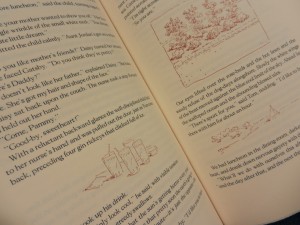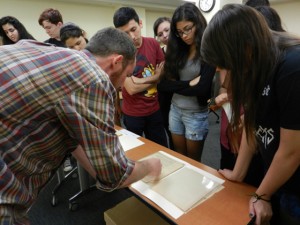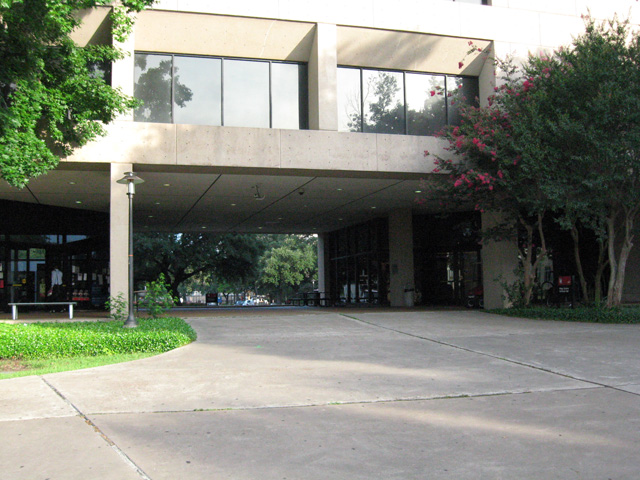
In addition to the over 7,000 linear feet of archival collections made available for study at the University of Houston Special Collections, we are also proud to offer over 100,000 rare and antique books for use in our reading room. Each month we will highlight a text from our collections.
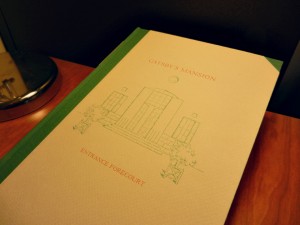
The Great Gatsby by F. Scott Fitzgerald, featuring artwork by Michael Graves
Book of the Month: The Great Gatsby by Francis Scott Fitzgerald; illustrated by Michael Graves (San Francisco : Arion Press, 1984)
Why So Special?: Required reading for just about every high school student as they come of age, Francis Scott Fitzgerald’s magnum opus is as American as Francis Scott Key’s offering. Routinely re-imagined every few decades on our collective silver screens to reflect our contemporary hopes and fears, Gatsby is often hailed as the novel on the subject of the American Dream, as amorphous an idea as that remains, full of all of our longing, anguish, confusion, desire, and “romantic readiness.” From Francis Cugat’s cover (commissioned and completed in the impatient haste of Scribners, seven months before the novel would even be ready–those eyes floating in the night, hinting at the enveloping darkness amid the carnival and light), to the sheer audacity and imagination of one James Gatz (convinced he cannot only reinvent himself of his own design, but he can will time to his bidding should he simply desire it enough), and on through the final words of the narrative, crystallizing our longing for and obsession with the illusory and the intangible (“So we beat on, boats against the current…”), The Great Gatsby has remained uniquely American.
Sometimes deceptively so.
For some it remains a pseudo-documentary of what Fitzgerald christened as “The Jazz Age,” The Roaring Twenties, “the most expensive orgy in history,” an American decade that found no proper suitor throughout her flirtations, and decided to stay on for the remainder of the century. To others it is a love story that sees desire run amok as it flies too close to a blazing white sun. Still others would present it as a cornerstone for the so-called “New York City novel,” an homage and tragic love story for Our New Paris; a story of The City that does not simply resign itself to the towering icons and alleyways of Manhattan, but also peers back behind the kitchen curtain windows of Long Island, revealing a complex web work of symbiotic and predatory class relations.
But Nick Carraway, our faithful and reliable narrator, would insist it has nothing to do with the New World’s metropolitan jewel, after all. He reflects on his “middle-west,” against the backdrop of that fateful summer of 1922:
That’s my middle-west–not the wheat or the prairies or the lost Swede towns but the thrilling, returning trains of my youth and the street lamps and sleigh bells in the frosty dark and the shadows of holly wreaths thrown by lighted windows on the snow. . . I see now that this has been a story of the West, after all–Tom and Gatsby, Daisy and Jordan and I, were all Westerners, and perhaps we possessed some deficiency in common which made us subtly unadaptable to Eastern life.
If the story of the American Dream is not rooted in the narrative of the so-called New World in the last handful of centuries leading up to that frenetic decade, full of all their blood and loss, then from where else does it originate? As if to underscore the point, it finally occurs to Nick while flailing about for his lost Eden at the tale’s conclusion, preparing to flee the corruption of the east, bound for his old, familiar home, he sprawls out on the Long Island beach and broods “on the old unknown world”:
And as the moon rose higher the inessential houses began to melt away until gradually I became aware of the old island here that flowered once for Dutch sailors’ eyes–a fresh, green breast of the new world. Its vanished trees, the trees that had made way for Gatsby’s house, had once pandered in whispers to the last and greatest of all human dreams; for a transitory enchanted moment man must have held his breath in the presence of this continent, compelled into an aesthetic contemplation he neither understood nor desired, face to face for the last time in history with something commensurate to his capacity for wonder.
And so it has remained for all of us, as we come of age in the New World, chasing the siren songs of phantasmal green lights hovering on our horizons.
This Arion Press imprint is limited to 400 copies and features the artwork of Michael Graves, of the New York Five fame, on the binding and throughout Fitzgerald’s prose. The text hops and springs over and around the illustrations of Graves, not unlike that running Buchanan lawn, “jumping over sun-dials and brick walks and burning gardens.” This particular volume also includes the signature of Graves below the colophon. Types used are Goudy Light and Piehler Capitals and the paper is French mould-made Rives, with a deckle edge.
Location: Available for study in the University of Houston Special Collections Reading Room (sorry, no beach reading with this one), Monday through Friday 9am-5pm. Bibliophiles or the simply curious should request call number PS3511.I9 G7 1984.
Some high school students spend their summer vacations soaking up the sun or playing computer games. But Houston-area students enrolled in the Wonderworks academic enrichment program spend five weeks of their summer intensively studying art, architecture, film, or literature. In early July, Wonderworks students in a class called Story Lines visited Special Collections to get up close and personal with one of author Larry McMurtry’s manuscripts.
The students had already read McMurtry’s novel The Last Picture Show, a coming-of-age story set in a small Texas town, and viewed the classic film of the same name. But their instructors Zachary Martin and Daniel Wallace, PhD students in the Creative Writing Program at the University of Houston, also wanted them to see first-hand the process McMurtry used in shaping his novel.
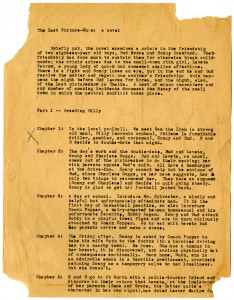
Larry McMurtry’s typed notes and outline for The Last Picture Show (from the Larry McMurtry Papers)
Students examined the original typewritten first draft, noting McMurtry’s handwritten word changes and replacements of characters’ names. (Would the beautiful Jaycee have been as alluring if she were still named Lavetta?) Martin led the class through a typed outline of the plot points McMurtry originally intended his story to follow, encouraging them to identify which ones stayed in the novel and which ones were discarded by the author.
Martin used McMurtry’s draft as a springboard to talk to the students about their own writing, and the necessity of building up their prose and ruthlessly editing it into something stronger. Perhaps viewing the original words of one Houston-related writer has inspired the next generation of Houston writers.
To be inspired yourself, please visit the Special Collections reading room Our summer hours are Monday – Friday, 9:00 a.m. to 5:00 p.m.
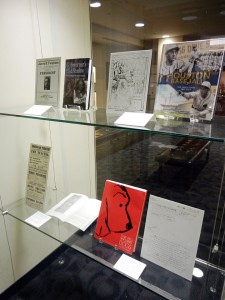
a new rotating, mini-exhibition of publications and projects produced in conjunction with research from the University of Houston Special Collections is now on display
The University of Houston Special Collections has begun a rotating exhibition showcasing highlights of publications and projects produced in conjunction with research from our collections. Located in the exhibit space adjacent to the Special Collections front door, in the Aristotle J. Economon, Hanneke Faber & Andrew J. Economon Elevator Lobby, “From Our Collections… Publications & Projects Featuring Research from the UH Libraries’ Special Collections,” shines a light on the fruits of research gathered from the rare books and archival collections preserved, safeguarded, and made available for study at the University of Houston.
With more than 7,000 linear feet of archival collections and over 100,000 rare books, the UH Special Collections provides daily research assistance to authors, filmmakers, artists, and patrons of all varieties. What they produce and share with us, enlightens, often breaks new ground, and rarely fails to astound.
Works and research currently featured include:
In the Governor’s Shadow: The True Story of Ma and Pa Ferguson, Carol O’Keefe Wilson (2014); featuring research from the Claude Elliott Texana Collection.
Houston Baseball: The Early Years 1861-1961, Mike Vance, editor (2014); featuring research from the George Fuermann “Texas and Houston” Collection and Houstonian Yearbooks.
“‘For the Relief of the Texians’: A Theatrical Benefit to Aid the Texas Revolution,” Pat Bozeman (2012); from Southwestern Historical Quarterly, featuring research from the Governor James V. Allred Papers.
The Big New Yorker Book of Dogs, The New Yorker Magazine (2012); featuring the short story “Chablis” by Donald Barthelme and research from the Donald Barthelme Literary Papers.
In addition to this new mini-exhibit, we pass along a gentle reminder to catch “LGBTQI Literature: Celebrated Classics and Contemporary Works,” currently viewing on the first floor of the M.D. Anderson Library. We hope you enjoy both of these exhibitions and look forward to sharing more in the future.
The recent post about Philip G. Hoffman Hall (PGH) failed to answer an important question: Why does it have a big hole in it? As with most cosmic questions, the answer to this one is that “it’s all connected.” In this case, PGH and its hole are connected to the change in the university’s master plan in the mid 1960s.
![1967 aerial view shows UH buildings arranged around several formal axes [UH Photographs Collection]](http://weblogs.lib.uh.edu/speccol/files/2014/05/UH-campus-1967-300x190.jpg)
UH Campus looking east (1967). Note street between Anderson Library and Ezekiel Cullen Building. UH Photographs Collection
Before the change in the master plan, a street ran through what is now Butler Plaza and passed between the Ezekiel Cullen Building and Anderson Library. See the 1967 aerial view of the campus. University planners decided to remove the street to create the plaza, and this required a new building opposite the library to provide a sense of enclosure.
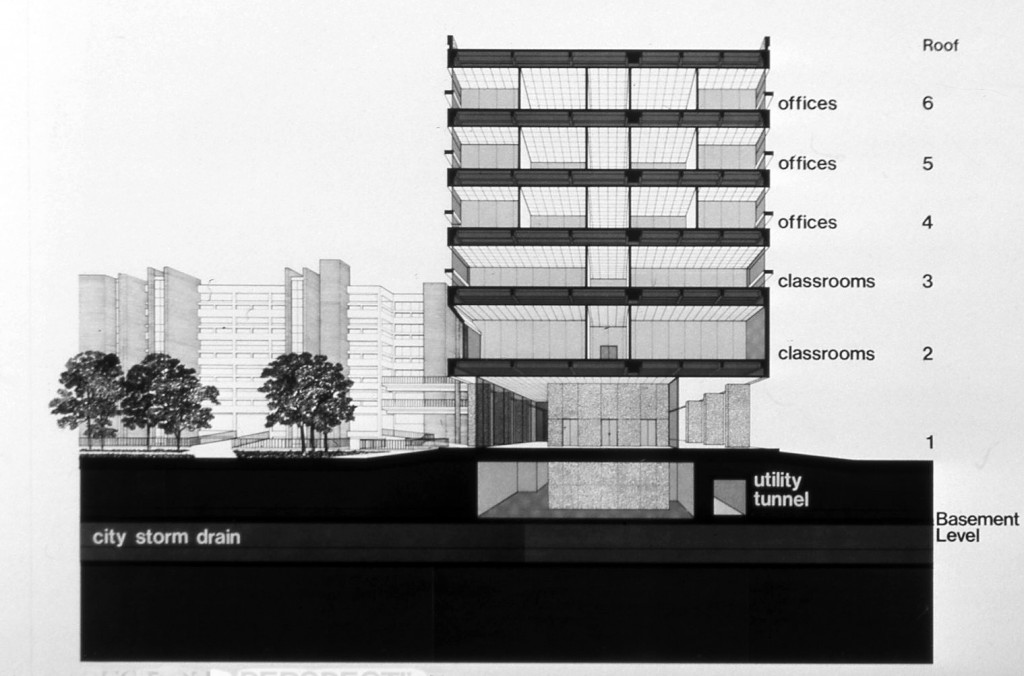
PGH, section view. Agnes Arnold Hall in background. Note storm drain below breezeway. Kenneth E. Bentsen Architectural Papers
But below the street was a major city storm sewer, and an easement prevented them from placing a building over it. Their solution was a building with a large hole in the center that left the area over the storm sewer open, providing access if it is ever needed. In the construction view below, looking to the southeast, excavation for a basement stops short of the center of the building.
![Philip G. Hoffman Hall Construction [UH Photographs Collection]](http://weblogs.lib.uh.edu/speccol/files/2014/07/PGH-Construction.jpg)
Construction of Philip G. Hoffman Hall (c. 1972) UH Photographs Collection
